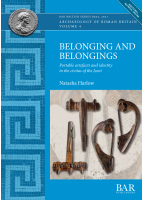Description
The Late Iron Age in northern East Anglia ended with the Boudican rebellion in 60/61 CE, after which the people known to classical writers as the Iceni were subsumed into the Roman empire. This volume presents new research which tests the archaeological evidence for the Iceni as a defined group, through analysis of the region’s distinctive material culture, particularly highlighting the impact of metal-detector finds on the available dataset for research. It evaluates the validity of the theory that the Iceni were slow to adopt Roman imports and luxury goods, either as a form of deliberate resistance or due to cultural conservatism following the failed revolt. The interpretive narrative of the Iceni as ‘Other’, in both Classical and modern sources, is also investigated. The artefact dataset used in this research is available as an accompanying digital download.
AUTHOR
Natasha Harlow completed her PhD in the Department of Classics and Archaeology at the University of Nottingham in 2018. She has extensive experience in artefact identification and recording, collections management and public engagement. Since 2008, she has been involved with the Caistor Roman Project, a community archaeology project focussed on the civitas capital of Venta Icenorum and its hinterland.
REVIEWS
‘Harlow’s enthusiasm provides a constant flow of information and ideas – there were innumerable occasions when I thought her comments were interesting and might repay further research, and the downloadable dataset will be a useful starting point for such enquiries.’ Jude Plouviez, Norfolk Archaeology, XLVIII (2021)
‘(A)n enormous volume of work that challenges the traditional, Roman historians’ accounts of the area and the people who lived within it in the Late Iron Age. The detailed and in-depth analysis that underpins this study – incorporating over 14,000 artefacts from multiple datasets – is phenomenal.’ Megan Dennis, Current Archaeology, August 2021
‘This is new material, uniquely looking at PAS data in the context of other finds from an area where metal-detecting is very long-established. It is high quality and a very helpful and detailed analysis.’ Professor Martin Millett, University of Cambridge
‘The book makes a useful contribution to our understanding of several topics such as the Iron Age to Roman transition period, and the nature of the study area in the early Roman period, and successfully questions previous interpretations that are still very much led by the historical narrative.’ Professor Ellen Swift, University of Kent











